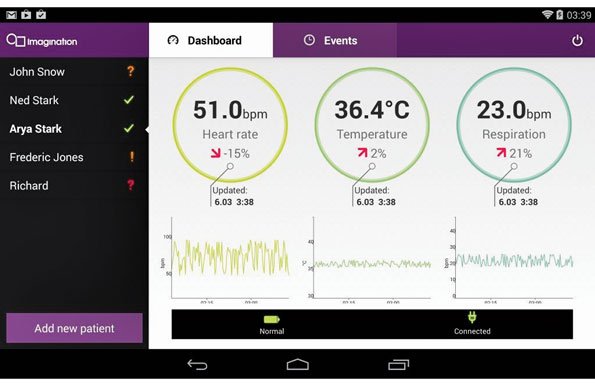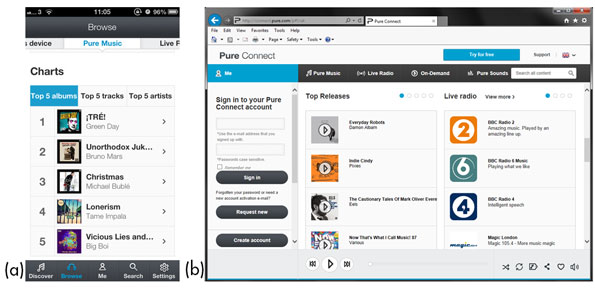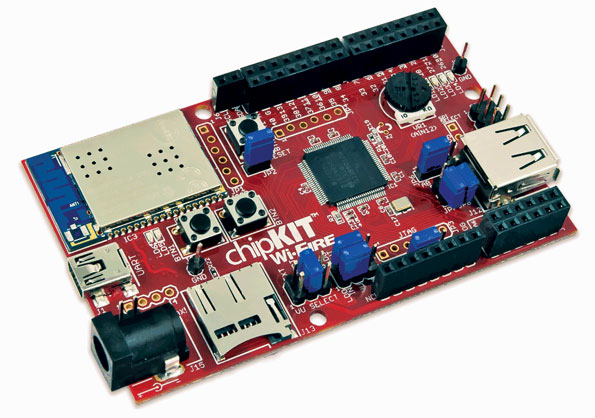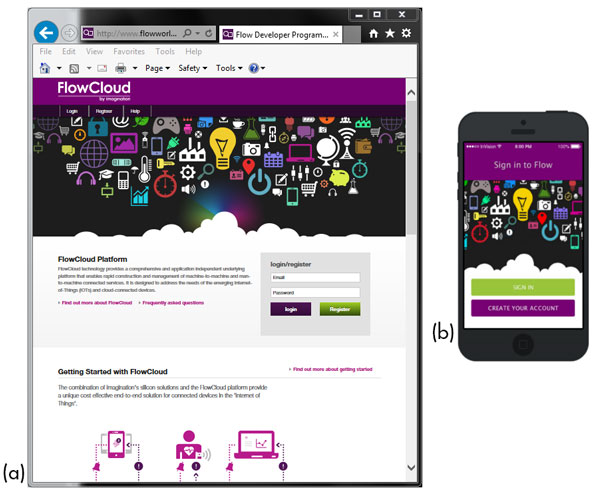



Feature Story
More feature stories by year:
2024
2023
2022
2021
2020
2019
2018
2017
2016
2015
2014
2013
2012
2011
2010
2009
2008
2007
2006
2005
2004
2003
2002
2001
2000
1999
1998
 Return to: 2014 Feature Stories
Return to: 2014 Feature Stories
CLIENT: IMAGINATION TECHNOLOGIES
July 18, 2014: Electronic Design
Smart 2.0 aims to bring together people, devices, and services in unique ways by providing a springboard for building connected products with value-added business opportunity.
We're at the beginning of a new technological revolution. Thousands of hitherto disparate and unrelated devices will become connected and able to share information via cloud-based services.
Imagine the latest movies automatically populating your tablet, simply because you placed a diary entry into your smartphone indicating you were taking a long-haul flight. Or, your home routinely switches into energy-saving mode after the last occupant departs, predicting when you are likely to return based upon smartphone GPS data. Or, you receive a message indicating all is well with a dependent relative, triggered automatically as your loved one follows a typical morning routine of taking medication, turning on the TV, and boiling the kettle.
These types of interactions ultimately will be made possible through thousands of connected sensors, actuators, and monitoring devices attached to physical objects, embedded within the fabric of buildings, or simply dispersed within the ambient environment. Each device generates relatively small amounts of data, which is then relayed through Internet protocol (IP) gateways to servers within large data centers. Powerful algorithms and data analytics engines are then employed to make sense of the data and draw conclusions about what is happening in the real world, allowing the technology to autonomously make intelligent decisions. This is Big Data, and it's already becoming a reality.
So how do you take a world of dissimilar devices and contrasting services, each of which act independently, and draw them together to make truly smart, coherent systems? The technical challenge is significant. Even the simplest solutions require a careful blend of apps and services, comprehensive software application programming interfaces (APIs), substantial Internet bandwidth, racks of servers capable of collating and storing information, and potent data analytics tools. It's daunting, time-consuming, and expensive, especially if your business is built around niche or highly specialized market segments.
To compete effectively in the Smart 2.0 technological revolution, the race to build truly smart products and services that consumers will love, you need a comprehensive, end-to-end, secure, and scalable solutions and the technical capability to bring them all together. Smart 2.0 aims to bring together people, devices, and services in unique ways by providing a springboard for building connected products with value-added business opportunity.
The technologies involved must provide a comprehensive, secure, and application-independent platform to enable rapid construction, management, and deployment of digital services. These are designed to address the requirements of emerging Internet of Things (IoT) and machine-to-machine (M2M) cloud-connected devices. They also are equally adept at handling everything from small real-time monitoring applications through full-scale Internet-based subscription services with several thousand users.
At the heart of any connected solution are core services and supporting infrastructure designed for cloud-based application deployment. State-of-the-art data centers host the platform and essential services, using cluster server technology for scalability and built-in redundancy to guarantee system uptime. In the meantime, failover data centers with read-only access safeguard the system from unplanned downtime.
Essential features of cloud-based applications include device and user management, asynchronous messaging services, event logging, and data storage facilities. Secure transactions and electronic payments support paid-for services, and administration and reporting tools provide dynamic views into data stored server-side, enabling analytics, monitoring, and management of user interactions plus live views into the status of registered devices. These tools create opportunity for aggregation and deep analysis of this data.
This aspect of Smart 2.0 and Big Data ultimately will enable the creation of advanced intelligent services. Several real-world examples exemplify Smart 2.0's potential, including simple home connectivity and full-fledged music subscription services.
The PowerBox smartphone and tablet application tracks and controls an appliance's electricity consumption so consumers can monitor the costs of running it (Fig. 1). The application also delivers remote control and scheduling of individual power sockets to enhance the use of connected appliances. For example, alarms can warn a consumer when power exceeds a defined limit, while scheduling can be used to turn on an appliance when electricity costs are lower.

1. The PowerBox smartphone and tablet application tracks and controls an appliance's electricity consumption so consumers can monitor the costs of running it.
The cloud provides essential back-end services including authentication and registration of the PowerBox units, collation of data, storage and management of scheduling information, and the asynchronous messaging necessary to support remote control of appliances.
PowerBox exemplifies how a relatively trivial application can utilize cloud-based services to build intelligence and security into the system. The technology could be built directly into plug sockets or alternatively integrated into residential gateways.
Several of these services may be combined to provide the basis of the connected smart home. For example, several services may be running on a residential gateway that manages your home TV subscription alongside broadband connectivity, home security, and e-health services. Hardware virtualization can enable multiple services to run independently and securely alongside each other.
Electronic healthcare is gaining popularity for remote monitoring and patient care within the home environment, hospitals, and emergency rooms. For these applications, the high integrity, security, and privacy of data are primary considerations.
For instance, a patch can provide live monitoring of vital signs including respiration, heartbeat, and body temperature. Each patch has a unique identifier that enables security by creating keys for data encryption. The identifier is also assigned to patient healthcare records, in effect creating a secure and trusted relationship between the physical world and digital domain.
The ecosystem supporting this connectivity enables multiple streams of data from the patch, itself having multiple sensors, to be directly and securely associated with each patient. It delivers live monitoring of vital signs through a PC, tablet, or Web-based application, either within the hospital or remotely over the Internet via encrypted connections.
Thresholds can be established on each data stream independently with events or alarms triggered if values go above or below acceptable limits. The system also may track the status of the patch itself, from initial use through disposal, confirming sufficient battery life or verifying that the patient is wearing the patch (Fig. 2).

2. Electronic healthcare can be delivered remotely via patient monitoring applications.
Aggregation of data sets within the cloud enables results to be collated from a potentially limitless number of patches, any or all of which can be presented to healthcare professionals via connected mobile apps or otherwise submitted to data analytics engines to derive and evaluate trends. All data sets are securely stored and managed within purpose-built data centers.
The potential of the cloud goes far beyond simple IoT and M2M applications. Today's cloud-based systems can host full subscription services with customer registration, secure billing, and payment systems built in as standard features. For instance, consumer audio electronics company Pure manages and maintains Pure Connect, a comprehensive music discovery, subscription, streaming and purchasing service (Fig. 3).

3. Pure Connect, a cloud-based intelligent music service, comprises a mobile app (a) and an associated Internet portal (b).
Dedicated servers and APIs provide the software framework and back-end services necessary to build applications to control multi-room audio. Android and iOS applications provide access into the cloud-based music services. They also control wireless speakers and connected (Internet) radios that form a complete multi-room audio solution.
Pure Connect provides a full Internet radio service, "listen again" services and podcasts, full streaming music, and the ability to directly play or purchase more than 22 million music tracks. The intelligence in the system enables content to be identified using audio fingerprinting technology. A single button press confirms the purchase. The app, music services, and back-end management tools are managed by state-of-the-art servers that provide a comprehensive suite of connected audio services with full support for account management, portal hosting, and online payment processing.
Smart 2.0 will enable a new world of intelligent devices such as FlowCloud from Imagination Technologies. FlowCloud is accessible to developers through software development kits (SDKs) supporting Android, iOS, and Web-based platforms. Comprehensive documentation including example code, a developer portal, and community forum all support it. Each developer account allows up to five devices to be connected for free, with storage allocated on servers in Imagination's state-of-the-art data centre.
Furthermore, Imagination's silicon partners have created several low-cost reference platforms supporting FlowCloud to help developers get started. For example, the chipKIT Wi-Fire platform features a MIPS-based PIC32MZ microcontroller and on-board Wi-Fi (Fig. 4).

4. The chipKIT Wi-Fire platform features a MIPS-based PIC32MZ microcontroller and on-board Wi-Fi.
Developers can use the Android and iOS FlowCloud apps to get development platforms up and running quickly. An intuitive user interface guides developers through hardware configuration right up to writing their own FlowCloud applications (Fig. 5).

5. Developers can use the Android and iOS FlowCloud apps to get development platforms up and running quickly. An intuitive user interface guides developers through hardware configuration right up to writing their own FlowCloud applications.
We're on the cusp of what will be an exciting technology revolution, with myriad connected devices extending light years beyond the PC with products seamlessly connecting to the Internet, their environment, and to each other. Also, Big Data aggregation and analytics will deliver new and innovative services boasting true intelligence. These devices and services will certainly impact the way we work and live in ways that we can't even remotely begin to dream of today!
Simon Forrest is senior marketing manager for Imagination Technologies. A graduate in computer science from the University of York, he has more than 17 years of experience in digital broadcast, reception, and broadband technologies. He also is author of several patents in this segment. Prior to joining Imagination, he worked for several years as an engineer in the set-top box industry throughout the transition to digital broadcast services and ultimately held the position of chief technologist within Pace plc.
Return to: 2014 Feature Stories